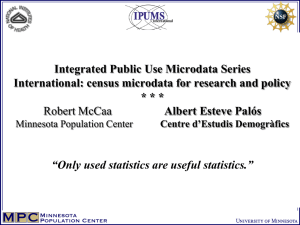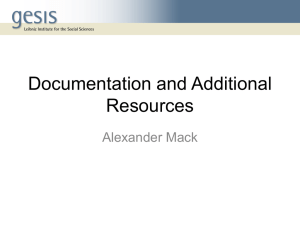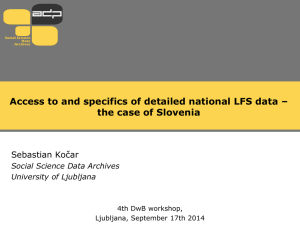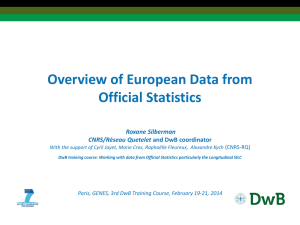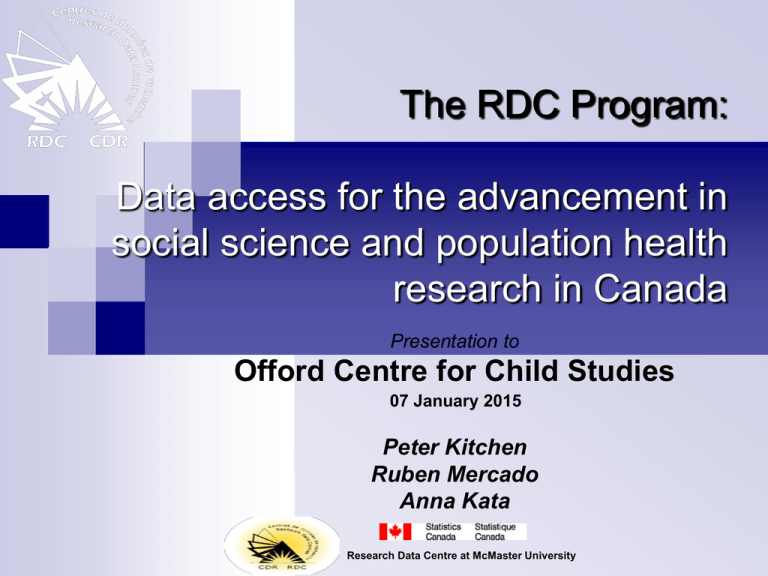
The RDC Program:
Data access for the advancement in
social science and population health
research in Canada
Presentation to
Offord Centre for Child Studies
07 January 2015
Peter Kitchen
Ruben Mercado
Anna Kata
Research Data Centre at McMaster University
RDC Program Origins:
StatCan / SSHRC 1998
Taskforce on social statistics
Improve data access (research data centres)
Promote research and training
Strengthen research-public policy links
What is a Research Data Centre ?
A secure Statistics Canada (StatCan)
environment on university campuses
managed by an Academic Director (university faculty member)
staffed by StatCan personnel
operated under Statistics Act ( “deemed employees”)
holding StatCan micro-data (+ admin files)
fully equipped for data analysis
housed by researchers with SSHRC/CIHR /Stat Can approved
project/s and security clearance
Continuum of data access
Data Access
Statistical Products
www.statcan.gc.ca
Custom Requests
Data tabulations
Microdata
PUMFs (DLI)
Daily releases
Real Time Remote Access
Cansim tables
Remote job submissions
Analytic articles
Research Data Centres
Aggregate tables
Federal RDC
Deemed employee inventory
University campuses with an RDC
Community of RDC users
Social Science….
Health….
Business and Management
Community Health and Epidemiology
Industrial relations
Epidemiology and Biostatistics
Political science
Family Studies and Gerontology
Sociology
Economics
Environmental Hygiene
Anthropology
Social Work
Neurological Science
Nutrition
Demography
Education
Psychiatry
Nursing
Geography
Statistics
Family Medicine
Dentistry
Psychology
Administration
Public Health
Kinesiology
….in rapid expansion
1500
1200
Completed
Active
845
900
703
572
600
449
373
300
517
374
280
249
181
0
14
2000
71
2001
46
2002
575
2003
125
2004
2005
2006
2007
2008
Number of research projects (2000-08)
RDC Projects by Offord Centre Researchers
(Past / Completed)
Project
Researcher/
Project Team
Dataset/s
Impact on Child Health and Development of
Socioeconomic Disadvantage Measured
(2002-2005)
Michael Boyle
John Cairney
Eric Duku
NLSCY
Trajectories of Antisocial Behaviour Among Immigrant
and Nonimmigrant Youth
(2006-2007)
Kathy Georgiades
Michael Boyle
NLSCY
First Nation Women's Emotional Health
(2002-2004)
Harriet MacMillan
NPHS
Trajectories of Conduct/ Antisocial Behaviour in
Adolescence: An Examination of Risk and Protective
Factors
(2009-2012)
Eric Duku
Michael Boyle
NLSCY
(Cycles 1-7)
RDC Projects by Offord Centre Researchers
(Past / Completed)
Project
Researcher/
Project Team
Dataset/s
Internalizing Symptoms and Youth Participation in Skill
Development Activities: Relationships Over Time
(2009-2010)
Terry Bennett
NLSCY (Cycles
2,3, 4 and 5)
The Effect of Special Education Interventions on Child
Emotional and Behavioural Functioning
(2004-2007)
Kathryn Bennett
NLSCY
Trajectories of oppositional and internalizing symptoms
in childhood
(2006-2010)
Khrista Boylan
NLSCY
Single-Parent Mothers and Outpatient Mental Health
Care Service Utilization: An Examination of
Predisposing, Enabling and Need Factors
(2002-2003)
John Cairney
NPHS
Family processes in neighborhood context: Influences
on externalizing behavior problems in children and
adolescents
(2006-2007)
Kathy Georgiades
NLSCY
RDC Projects by Offord Centre Researchers
(Past / Completed)
Project
Researcher/
Project Team
Dataset/s
Emotional and behavioural problems in childhood and
obesity later in life
(2011)
Ryan Van Lieshout
Kathy Georgiades
Michael Boyle
NLSCY
Effects of Maternal Diabetes Mellitus during
Pregnancy and Fetal Anthropometrics on
Neurobehavioral Development and Psychological
Functioning in Children and Adolescents
(2008-2012)
Ryan Van Lieshout,
Michael Boyle
NLSCY
The Impact of Living Arrangements of Lone Mothers
on Child Outcomes
(2005-2006)
Ellen Lipman
Eric Duku
NLSCY
The influence of sex and immigrant status on risk for
Intimate Partner Violence (IPV): Evidence from the
Canadian General Social Survey
(2011-2014)
Melissa Kimber
GSS Cycle 23
(2009)
RDC Projects by Offord Centre Researchers
(Current)
Project
Researcher/
Project Team
Dataset/s
Modeling the Influences of Chronic Illness and
Family Environment on the Self-concept and
Mental Health Outcomes of Adolescents
(2012-2015)
Mark Ferro
Michael Boyle
Laura Duncan
NLSCY
Psychiatric comorbidity in adolescents with
chronic illness
(2013-2017)
Mark Ferro
CCHS 2012
(Mental Health)
Microdata Files Available for Access in the RDCs
(as of December 2014)
Data Type / Status
Active
Inactive
One
Time
Pilot
Longitudinal
2
7
0
0
Cross-sectional
20
17
18
0
0
0
4
Census long form
0
0
+ Focus content
CCHS = 6
GSS = 8
+ 1 historical database
(1986-2006)
Administrative
Census data
3
Census short form
NHS
Active
Surveys that continue to be conducted on a regular basis.
Inactive
Surveys that have been discontinued.
While new data collection has stopped, the original files are available in the RDC.
One Time
Surveys that were conducted at a particular time for a specific purpose.
Pilot
These are usually associated with administrative data sets that are made available to a few researchers
in order to assess data quality, establish and refine data confidentiality rules and address other related data issues.
The data sets may be made available for regular access in the RDC after the pilot phase.
Relevant Longitudinal microdata
National Longitudinal Survey of Children and Youth (NLSCY: 1994-2009)
Long-term study of Canadian children that follows their development and well-being from
birth to early adulthood.
Factors influencing a child's social, emotional and behavioural development and impact on
child's development over time
Youth in Transition Survey (YITS: Cycles1-6 --1998–2009)
YITS aims to provide policy-relevant information on educational and labour market
pathways of Canadian youth --- transitions in education, training and work
A longitudinal survey of two groups: ages 15 and 18-20, surveyed every two years.
Content includes formal education and labour-market experiences and influencing factors
such as family background, school experiences, achievements, aspirations, expectations
and employment experiences.
Longitudinal Survey of Immigrants to Canada (LSIC 2001, 2003, 2005)
Information on factors that facilitate or hinder integration of new immigrants to life in
Canada in terms of education, housing, language, employment
Study focus: Population 15+ who arrived in Canada in 1999/2000.
Relevant Longitudinal microdata
Ontario Child Health Study (OCHS: 1983, 1987, 2000)
StatsCan - McMaster study in Ontario to evaluate the impact of early childhood
experiences and development in later health, quality of life and functioning.
Original data –1983; OCHS 1987/2000 – longitudinal survey based on 1983 data.
Longitudinal and International Study of Adults * (New) (LISA: 2012Wave 1; 2014 – Wave 2 – data being processed)
Monitors Canadian households in the four key domain variables: education, employment,
training, and family and personal characteristics.
“Longitudinal” – follows the same households every two years; children aged 0-14 in each
household at the time of survey will be asked questions in later waves when they turn 15
years old.
Survey data linked to tax data (income, pension, etc.)
At wave 1, LISA was integrated with the Programme for the International Assessment of
Adult Competencies (PIAAC), (also known as the International Study of Adults (ISA)). The
two surveys share a portion of their samples and the data collection activities were
integrated.
Relevant Cross-sectional
microdata
Canadian Community Health Survey (CCHS:2001-2013)
Information related to health status, health care utilization and health determinants for the
Canadian population
Coverage: 12 years of age and older for analysis at health regional level
Focus content on mental health (2002; 2012); on nutrition (status, eating habits– 2004);
neurologic conditions (2010/2011) and vitamin supplement use (2013); nutrition (2015)
Additional questions on neighborhood environment (e.g. satisfaction) (2011)
General Social Survey (GSS: 1986-2012)
Monitor changes in the living conditions and well-being of Canadians over time
Provide information on specific social policy issues of current or emerging interest
Covers ages 15+ ; Focus content – Family, Caregiving, Time Use, Victimization, Social
Network, Health, ICT Use, Education, Work
Communities Survey (CS – 2004, 2005; NLSCY – 1999-2001)
Information about a sample of kindergarten children living in selected communities, using
same questionnaires and direct measure instruments developed for the NLSCY.
Additional data using the Early Development Indicator (EDI), a questionnaire developed
and administered by the Canadian Centre for Children at Risk at McMaster University
(renamed the Offord Centre!)
Relevant Cross-sectional
microdata
Canadian Health Measures Survey (CHMS: Available Cycle 1
(2007-09); Cycle 2 (2009-11); Cycle 3 (2012-13); Cycle
4 (2014-15)
Household interview on health and direct physical measures of individuals 3-79 years old
at a mobile examination centre (MEC) – a mobile clinic.
Physical: blood pressure, height, weight and physical fitness, blood and urine samples to test for chronic and
infectious diseases, nutrition and environment markers.
Household interview: nutrition, smoking habits, alcohol use, medical history, current health status, sexual behaviour,
lifestyle and physical activity, the environment and housing characteristics, as well as demographic and
socioeconomic variables.
Information can help create national baseline data on obesity, hypertension, cardiovascular disease, exposure to infectious diseases, and environmental contaminants.
Allows determination of relationships between disease risk factors and health status, and
to explore emerging public health issues
Microdata file: @5,600 participants per collection cycle with 5 CHMS age groups: 6-11; 1219; 20-39; 40-59; 60-79.
Canadian Tobacco, Alcohol and Drugs Survey (CTADS 2013
soon ; CTUMS 2002-2008 – already available)
CTADS = CTUMS + alcohol and drug use among ages 15-19 and 20-24
CTADS= biennial survey to measure freq. of cigarette smoking, amount smoked, related behaviors,
prevalence and frequency of alcohol use, drug use and the extent of harm.
Microdata file: CTUMS 2008 = @23,000 household records; @9,700 individual records
Relevant Cross-sectional
microdata
Childhood National Immunization Coverage Survey (New) (CNICS:
2013)
Every two years, collects information on national immunization coverage for childhood
vaccines (publicly-funded); also assess knowledge, attitudes, and awareness of vaccines
including safety, sources of information, reasons for not immunizing, etc.
Covers girls and boys aged 2, 7, 17 and girls 12-14 years old, living in the 10 provinces
and three territories; Respondents were randomly selected from an administrative file
available at Statistics Canada. Stratified by age and by province and territory to ensure
representative sample while remaining efficient. The sampling unit is the child, but the
respondent is their parent or guardian; the design prohibits two children from the same
household from being selected for the sample.
Microdata file @2,800 records;
Survey of Approaches to Educational Planning (SAEP: 2013, 2002)
How parents are preparing their children (ages 0-17) for post-secondary education –
primarily financial saving strategies (e.g. RESP, etc. ) + parents/guardians' attitudes and
values regarding post-secondary education + child's commitment to education
Coverage: SAEP is a supplement survey of the Labour Force Survey (LFS). Coverage
was modified to include only those households with at least one child aged 17 (in SAEP
2002 – ages 0-18) and under and, within those households, only one randomly selected
child.
Microdata file @9,200 records for SAEP 2013
Relevant Cross-sectional
microdata
Canadian Survey on Disability (CSD: 2012)
Canadians aged 15 + with disabilities reflecting social model of disability (vs. medical)
Information on type and severity of disability, use of aids and assistive devices, help
received or required, educational attainment, labour force status, experiences and
accommodations at school or work, and ability to get around the community.
Similar content to PALS (2006, 2001) and HALS (1991, 1986)
BUT streamlined and updated; corrected weaknesses in question wording; better identification of persons with
mental/ psychological, cognitive and “other” types of disabilities using Disability Screening Questions (DSQ);
Should not be analytically compared to PALS and HALS
Microdata file: with disability based on DSQ @21,000 records; false positive – reported
not limited but could be @8,600 records; with long-term health condition but did not meet
DSQ @3,100 records
Canadian Internet Use Survey (CIUS: 2005, 2007, 2009, 2010, 2012)
to assess the availability of internet to households and individuals 16yo + in Canada
to understand how individuals use the Internet, including their frequency and intensity of
usage, and demand for specific online activities (e.g. entertainment, study, work, social
networking, etc.)
Microdata file: @30,000 household records; @22,000 individual records
Relevant Cross-sectional
microdata
Programme for International Student Assessment
(PISA: 2000, 2003, 2006, 2009, 2012)
Developed and implemented by OECD countries, survey assess whether 15 year-olds
approaching end of compulsory education acquired the knowledge and skills essential
for full participation in society.
Covers three domains: reading literacy, mathematical literacy and scientific literacy; 2/3
of each cycle focus on “major” domain
Every three years; new 15 years old sample every cycle;
Microdata file has @21,500 records for PISA 2012
Program for the International Assessment of Adult Competencies
(PIAAC 2012; IALSS 2003; IALS 1994)
OECD- initiated survey to provide information regarding change in the distribution of skills
(reading and math) over the years including problem solving in technology-rich
environments to inform decisions on the composition and content of remedial skill
development course and adult education.
Canadian adults aged 16 to 65 not residing in institutions or on Aboriginal reserves;
Microdata file has 27,000 records for PIAAC 2012 wherein @11,200 are <20 years old
Relevant Cross-sectional
microdata
Aboriginal Peoples Survey (APS: 1991, 2001, 2006, 2012)
Key statistics to inform policy and programming activities aimed at improving the well-being
of Aboriginal Peoples (First Nations people living off reserve, Métis and Inuit aged 6+)
Funding provided by Aboriginal Affairs and Northern Development Canada, Health Canada
and Employment and Social Development Canada (formerly HRSDC)
Collected every five years; Data on the social and economic conditions of Aboriginal
people in Canada in terms of education, employment, health, language, income, housing
and mobility.
Collects unique and detailed data on education, employment and health data not available
from any other source.
Coverage: 2006 APS = Aboriginal identity only
2012 APS = Aboriginal identity + Aboriginal-ancestry
Content: 2011 NHS = level of education and on major field of study;
2012 APS = number of schools attended, exposure to Aboriginal languages,
school climate and support, frequency of reading, participation in extra-curricular
activities, peer influences and plans for further schooling.
Microdata file has @28,400 records for APS 2012
Relevant One Time Survey
Microdata
Aboriginal Children's Survey (ACS: 2006)
Early development of Aboriginal children and the social and living conditions
in which they are learning and growing.
Covers data about Aboriginal (Métis, Inuit, and off-reserve First Nations)
children under 6 years of age in urban, rural, and northern locations.
Microdata: 12,800 records with relatively equivalent number of sample for
ages 0-1, 2-3, 4-5
Maternity Experiences Survey (MES: 2006)
Sponsored by the Canadian Perinatal Surveillance System of the Public Health Agency
of Canada, the goal was to gain information that could help improve the health and wellbeing of pregnant women, mothers and infants in Canada.
Information on pregnancy, labour, birth and postpartum experiences.
Covers women who had a single birth at time of survey; at least 15 years of age at the
time of baby's birth; baby was born in Canada and lived with the mother at least one
night per month.
Microdata: @8,500 women.
Relevant One Time Survey
Microdata
International Youth Survey (IYS: 2005-06)
Canadian portion of the International Self-Report Delinquency Study (ISRD) involving
youth in Grades 7 to 9 in @30 countries, Europe, US and Canada.
comprehensive information about delinquency and misbehavior of young people. Data
can be analyzed within the context of school policies and programs, local crime
problems, and the socio-demographic make-up of local communities.
Microdata file : @3200 grades 7-9 students belonging to the Toronto District School
Board or a private school in the Toronto Metropolitan Area, at the time of collection
Information and Communications Technologies in Schools Survey
(ICTSS: 2003-2004)
Provides a benchmark data on the integration of ICT in education - current ICT
infrastructure in schools; location and time students can access computers; types of
internet and intranet connections; teacher skills and training in ICT; capabilities in
regards to online courses and videoconferencing; attitudes toward ICT; ICT challenges.
Surveyed 6,676 of the 15,541 schools (43% response rate); includes elementary and
secondary schools (except Catholic schools) as well as trade/vocational schools,
schools in aboriginal communities, social service centres.
Relevant Administrative
Microdata
Vital Statistics Data
Through the Canadian Vital Statistics system, all provincial and territorial vital statistics registries
in Canada now supply microfilm or optical images of vital statistics registration forms to
Statistics Canada
Vital Statistics – Births (VSD Births: 1974-2011)
Microdata provide all live births in Canada linked by socio-economic and geographic
characteristics
Allows for fertility studies (i.e. age-specific fertility rates, parity, birth types, infant health
/ mortality, seasonality of birth occurrences, etc.) in relation to socio-economic (i.e.
immigrant / Canadian born, cultural diversity, living arrangements and risk of
conception, etc.) and geographic variables through usual place of residence of mother
Place of birth and place of residence of mother are based on census geographic codes
where distance could be a proxy to measure access to health facilities
Vital Statistics – Deaths (VSD Deaths: 1974-2011)
Microdata provide all deaths in Canada linked by geographic characteristics
Allows for mortality studies using demographic and medical (cause of death)
information relative to locality of death and/or usual place of residence of the deceased
The cause of death variable is classified according to the WHO "International Statistical
Classification of Diseases and Related Health Problems" (ICD).
Relevant Administrative
Microdata
Canadian Cancer Registry (CCR: 1992- 2010; 2011, 2012); 2013 upcoming)
Patient based database collected from all provincial and territorial cancer registries
(PTCRs); Data documents both the individual with the cancer and the characteristics of
the cancer.
Great authoritative source to provide a solid baseline about cancer incidence among
children and youth (kind and number of new cases diagnosed in a year); studies on
cancer survival, cancer mortality / death, descriptive and analytical epidemiological
studies to plan, monitor and evaluate broad range of cancer control programs (e.g.
screening, etc.), identifying risk factors for cancer, research in health services and
economics
Each year, approximately 180,000 new primary cancer records are loaded into the CCR
database.
Pilot Projects – Relevant
Incident-based Uniform Crime Reporting Survey (UCR: cases
collected from 2007-2011)
Incidence and characteristics of police-reported crime in Canada (collected
from provincial police authorities); useful for crime analysis, policy and
legislative development, administrative planning and international comparisons.
Three microdata files: 1) Incident; 2) Accused/Charged; 3) Victim
Incident-based or population based (e.g. child / youth) crime studies
Not intended / statistically reliable for trend analysis
Homicide Survey (HS: cases collected from 1961-2006)
Police-reported data on the characteristics of all murder incidents, victims and
accused persons since 1961 and all homicides (including murder,
manslaughter and infanticide) since 1974.
Three microdata files: 1) Incident; 2) Accused/Charged; 3) Victim
Information received by the Homicide Survey is compared to the data reported
to the UCR Survey
Pilot Projects – Relevant
Ontario Social Assistance Data (OSAD: 2003-2013)
Ontario social assistance data derived from the Ontario Works Program and
the Ontario Disability Support Program (ODSP)
Data would include de-identified Ontario income support microdata of benefit
unit (family), member, pay detail (benefit), income / deduction information and
skills.
Monthly time-series data on Ontario Works and ODSP provincial caseloads
from 1990 to 2013 could be made available.
McMaster RDC Website Information
PUMF vs. Microdata
Microdata files available (updated regularly)
Select Survey presentations
McMaster RDC Newsletter
How to Apply / Types of Data Access
Faculty research
Masters or Doctoral research
Program of Research
Academic course
Unaffiliated academic research (fee-for-service)
The proposal
Project Title
Name and Affiliation of Investigators
Project Objectives
Description of the Methods
Data Requirements
(including justification for microdata)
Critical Dates
28
Statistics Canada • Statistique Canada
13/04/2015
Contact information
LOCATION
Mills Memorial Library, Rm 217
McMaster University
1280 Main Street West
Hamilton ON, L8S 4L6
Academic Director: Byron Spencer (spencer@mcmaster.ca)
Analysts:
Peter Kitchen (rdc@mcmaster.ca) 905-525-9140 ext. 27968
Ruben Mercado (rdc2@mcmaster.ca) 905-525-9140 ext. 27967
Extended Hours: Anna Kata (rdc3@mcmaster.ca) 905-525-9140 ext. 27968
McMaster RDC Website:
McMaster RDC
CRDCN Website:
rdc-cdr.ca




